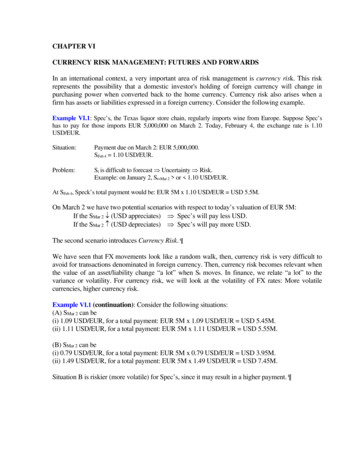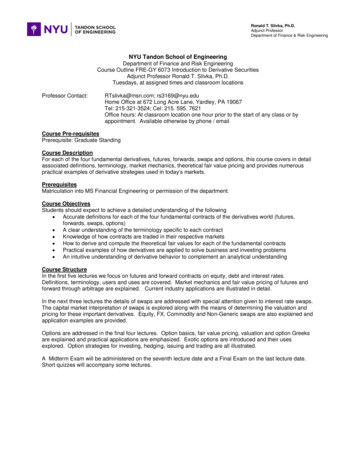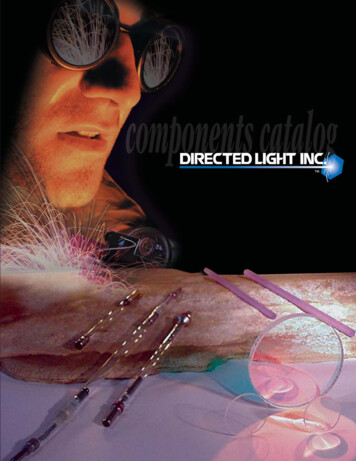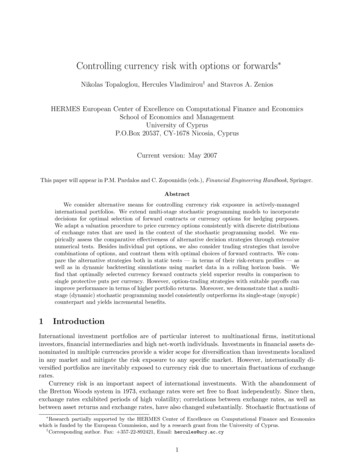
Transcription
DIRECTEDENERGYFUTURES 2060Visions for the next40 years of U.S.Department ofDefense DirectedEnergy technologiesApproved for public release; distribution is unlimited. Public Affairs release approval # AFRL-2021-1152
D I R E C T E DE N E R G YF U T U R E S2 0 6 0This document was authored by the Office of the U.S. Air Force’s Chief Scientist for DirectedEnergy, Air Force Research Laboratory, for the Office of the U.S. Secretary of Defense’sDirected Energy Community of Interest. We are grateful for contributions from the U.S. NavalResearch Lab, Office of Naval Research, U.S. Army Space and Missile Defense Command, JointIntermediate Force Capabilities Office, other components of the Department of Defense, LosAlamos, Sandia and Lawrence Livermore National Laboratories, collaborators from industry,academia, and international partners affiliated with the North Atlantic Treaty Organization (NATO).Approved for public release; distribution is unlimited. Public Affairs release approval # AFRL-2021-1152i
D I R E C T E DE N E R G YF U T U R E S2 0 6 0Directed Energy Futures 2060Table of ContentsExecutive Summaryiii1.Introduction 12.2.12.22.32.42.52.6Trends 4Directed Energy Range and Focus of Military Power 4Directed Energy Scalability and Flexibility in application ofpower within phases of conflict 9Precision of Directed Energy Weapons in special operations 15Directed Energy Weapons for intermediate forces operations 18Speed of application of power within the battlespace 20Directed Energy platform concerns and affordability 233.Futures States254.Recommendations and Conclusions295.References 316.AppendicesA. Future State VignettesB. Participating OrganizationsC. 2060 AssumptionsD. Acronym ListE. Description of Units of Measurementii353541424344
D I R E C T E DE N E R G YF U T U R E S2 0 6 0Executive SummaryWe maintain that we are approaching or have passed a tipping point for the criticality of Directed Energy(DE) capabilities as applied to the successful execution of military operations for the United States, Allies,and for the United States’ rivals and potential adversaries. DE is a focused beam of electro-magneticenergy that is used to enable or create military effects, when used in conjunction with other militarysystems, including kinetic weapons. Specific examples of DE are lasers, radio frequency devices, highpower microwave, millimeter wave, and particle beam technology used to create a military effect, e.g.deny, degrade, damage, destroy, or deceive.A growing number of nations, are realizing the potential of DE for a variety of militarily relevantmissions. At least 31 nations today have DE weapons for counter unmanned airborne system (c-UAS)missions, such as base defense. Other examples of pervasive DE technologies include pointer andilluminator lasers. Today both state and non-state-actors have used low-power lasers during operations:military, policing, during protests, and to imperil civil and military pilots. Counter sensor and counterelectronic DE weapons are effective today from a variety of platforms (airborne, ground, and ship based),across various phases of war and intensities of conflict.Recognizing the increasing military criticality of DE capabilities, we are moving aggressively to retainU.S. DE leadership. This increase in DE military significance is driven by convergence of trends in: The science and technology enabling greater DE performance and capabilities The characteristics and requirements of offensive and defensive operations across thebattlespace, and The role and characteristics of information in maintaining military parity or dominanceacross the battlespace.The increased criticality and competition of DE capabilities argues for a national strategy that guaranteesU.S. DE military capabilities ensuring U.S. national interests and power.Such a strategy must incorporate short-, mid- and long-term perspectives on the future of DE capabilitiesboth generally and specifically as they apply to military operations. This report presents results from thefirst of a three-step effort to provide that long-term vision towards the development of this strategy. Theother steps will be completed in subsequent workshops. The three steps are:(1) Describe a range of possible Directed Energy future scenarios and explore thecharacteristics of those scenarios and their implications for national and military power.(2) Understand the drivers and inflection points for those scenarios most advantageous anddisadvantageous to the U.S with respect to national defense.(3) Determine the minimum essential capabilities and actions required to implement aDirected Energy strategy meeting military needs.For the first step, the DoD Directed Energy Community of Interest and the Air Force Research LaboratoryDirected Energy Directorate, hosted a DE Futures 2060 Workshop in October 2019, to explore the statusand role of directed energy capabilities 40 years into the future. The participants, comprised of DE expertsfrom several agencies and services in the DoD, DoE, NATO, industry, and academia. The assembledexperts assessed the historical and current state of DE technologies, and used those assessments toforecast DE technology, relevance, and proliferation into the future across a range of militarily relevantprinciples. They used an alternative futures analysis technique to develop a range of future scenariosand to explore how they relate to national power. This document summarizes and expands upon thosediscussions.iii
D I R E C T E DE N E R G YF U T U R E S2 0 6 0The workshop explored potential DE futures along three axes:Advancements in DE systems performanceWhat performance can Directed Energy systems provide based on advances in DE science andtechnology?Prevalence of DE capabilitiesHow widely and at what level are Directed Energy capabilities proliferated across nation states andother entities?Military significance of DE enabled capabilitiesWhat is the military utility of DE enabled capabilities in the execution or disruption of the kill chain,across domains and across the phases of conflict?Along each of these axes or dimensions, the workshop participants defined three states bounding thepotential futures for Directed Energy in 2060: optimistic, conservative, and pessimistic. These states werecarefully developed to realistically span the range of possible future states, and to avoid the pitfall ofwishful thinking as to the state along any axis.Combinations of the states along the axes or dimension, produced 27 possible futures. A subset ofthese futures were developed in more detail to determine their implications to U.S. power and to thedevelopment of a national DE strategy. A sufficient number of the futures were examined to determinethe full range of possible threats and opportunities for U.S. military power. The specific futures examinedwere:Future 1 Prevalence, Technology, and Military Utility all Optimistic CaseFuture 2 Prevalence, Technology, and Military Utility all Pessimistic CaseFuture 3 Prevalence, Technology, and Military Utility all Conservative CaseFuture 4 Technology, and Military Utility Optimistic Case, Prevalence Pessimistic CaseFuture 5 Prevalence and Military Utility Optimistic Case, Technology Pessimistic CaseFuture 6 Prevalence Conservative, Technology Optimistic Case, and Military Utility Pessimistic CaseExamination of these futures and their implications led to the following preliminary conclusions.1. The U.S. and its close Allies increasingly rely on electromagnetic superiority to maintainoperational communications and avoid detection. Therefore, we are approaching (or havepassed) a tipping point in the criticality of directed energy capabilities to successfulmilitary operations for the U.S., Allies, peer competitors, and potential adversaries.2. Our potential adversaries and rivals will increasingly challenge U.S. leadership in DEmilitary capabilities.3. This increased criticality and competition argues for a national Directed Energy strategyto ensure that the U.S. has the DE-enabled military capabilities required to protect ournational interests in 2060.4. The future state methodology ensures that an appropriate range of futures are consideredthat avoid the historic tendency for the DE community to overpromise in terms of thematurity of DE technology, and underperform as to the operational capability that DEcan provide.iv
D I R E C T E DE N E R G YF U T U R E S2 0 6 05. Even with a pessimistic estimate of the advance in DE science and technology, DEcapabilities will have significant military utility in the battlespace of the future, due tothe unique capabilities of DE systems in terms of precision, range, flexibility, scalability ofeffects, deep magazine, and active probing of the battlespace across all domains andphases of conflict. Today, DE weapons are used by all major military powers for a varietyof effects.6. The increase in military significance of DE systems depends on the ability to converttechnological advances into operational capabilities. Technical challenges remain,that require research and development, as well as consideration for all elements of theDOTMILPF and life-cycle management.7. Under conservative or optimistic projections of advances, DE capabilities will be a vitalcontributor to military operations within, and across all domains for the U.S. and itspotential adversaries. Because the pace of conflict is forecast to quicken, certain counterair operations of the future may only be possible with the speed advantages DE offers.8. World-wide trends hint at a flatter economic and technological world in 2060. Whilethe U.S. desires to retain its dominant position in DE operational application, science andtechnology, this position will be difficult to maintain with a large set of peer competitors.9. For all futures examined, DE military applications will be sufficiently important thatlagging behind peer competitors in areas of DE military capabilities risks the U.S.military’s ability to project power and protect national interests.10. The most probable, achievable state for the U.S. in 2060, is parity in DE science andtechnology and operational capabilities with the expanded set of peer competitors.The importance of assuring this parity is directly proportional to the level of proliferationof significant DE military capabilities and the level of increased performance, enabled byadvances in DE science and technology, by those nations who lead in DE.11. The key challenges in developing a strategy to assure those futures with the U.S. havingat a minimum, parity with peer competitors are:a.Determining the breadth and focus of investments across the complex space ofDE science and technologies with potential for military applications.b. Developing the human capital needed to perform the science and technology andengineering, required to transition the technology to operational capability.c.Ensuring the ability to adjust quickly to new advances or breakthroughs.d. The ability to rapidly convert those advances or breakthroughs into operationalcapabilities, ideally asymmetric capabilities, so as to match or outpace ourcompetitors and potential rivals.12. This first workshop and associated report provide a vision, valuable initial inputs for therefinement of the national strategy for Directed Energy, and argues strongly for continuation of theefforts, as critical inputs to national strategy development.v
D I R E C T E DE N E R G YF U T U R E S2 0 6 01. IntroductionDirected Energy (DE) is defined for military applications as the ability to project electromagnetic energyeither broadly to provide information probing of the battlespace, or in a focused manner sufficient toproduce a defensive or offensive effect at militarily relevant distances within the battlespace. The militarysignificance of Directed Energy Weapons (DEWs) has long been recognized for ability to engage atthe speed of light, propagating vast distances with precision. Other benefits include potentially deepmagazines, meaning the capability to fire many shots without need to physically rearm the weapon,and low cost per shot. DE can also actively probe targets and threats, i.e. laser pointers (commonlycalled designators), laser and radiofrequency (RF) tracking, also called radar. The final benefit worthmentioning, is the ability to cause scalable and flexible effects, to include destructive, damaging,disruptive, non-lethal, deceptive, and unattributable effects.Today in the early 2020s, world-wide DE already plays important military roles in counter-air defense,target identification, tracking, counter intelligence search & reconnaissance (ISR), and electronic warfare(EW). U.S. military thinking on electromagnetic spectrum operations defines DE in the context ofelectronic attack systems designed to disrupt or degrade an adversary’s signals, deliver communicationssupporting cyperspace operations, or disable and destroy targets susceptible to high-energyelectromagnetic radiation (U.S. Joint Chiefs’ of Staff 2020). Today there are historical definitions thatdelineate DE and EW weapons which are otherwise similar in function and form. Because the historicaldefinitions are unlikely to be important 40 years in the future, in this report we considered DE and EWweapons to be synonymous, especially with respect to applications of information superiority that replyupon electromagnetic spectrum superiority to accomplish military missions.The electromagneticspectrum of light(see Figure 1) spansfrequencies , startingat a few Hertz (1Hz 1oscillation of theelectromagnetic fieldof light per second),the frequenciesat which modernelectrical infrastructureoperate. The spectrumcontinues throughradiofrequencies,microwaves, andFigure 1: The electromagnetic spectrummillimeter waves, atwhich most moderncommunication systems operate, and then through the infrared, visible, and ultra-violet (UV) that areoften referred to as the optical part of the spectrum. Finally, the most rapidly oscillating frequencies areX-rays and gamma rays.Because most modern electrical and communication (e.g., cell phones, computers, radios) systems operate inthe few Hz through optical frequency ranges, DE plays a vital role in the global technology of this and futureeras. While the power of light is still considered mysterious by many people, and DE systems still consideredthe devices of science fiction, today DE systems commonly exploit the electromagnetic spectrum. They are ofLight can be thought of as photons, particles of light, or an electromagnetic field that propagates time and space like awave. The wavelength and frequency of light are related; wavelength is inversely proportional to frequency.1[1]
D I R E C T E DE N E R G YF U T U R E S2 0 6 0military and commercial utility, and pervasive in manufacturing and medical sectors of modern society. Forexample, in the early 2020s, specifically as of March 2021, the U.S. death toll from the COVID-19 pandemichas already surpassed the combined total number of American military service member lives lost duringcombat in World War I, II, and the Vietnam War. UV lights and other forms of light are standard equipmentfor sanitizing medical equipment and ventilation systems, helping to prevent spread of the disease.Although DE is most certainly not a cure-all, there are other technologies on the horizon that make useof the power of light in perhaps surprising ways. For example quantum-information can be encoded onpulses of laser light, enabling higher security communications. In another example, there are projectsunderway in the U.S. (U.S.A.F. 2019, Mosher 2018) and in China (Rosenbaum 2019) that use DE totransport or “beam” power to remote and disadvantages locations.Looking to anticipated future trends, it is our assessment that in a conservative forecast of the future,applications of electromagnetic spectrum dominance are likely to create significant asymmetric militaryadvantages. A historical example of DE that also shows the flexibility DEWs provide to informationsuperiority operations, is the example of illuminator lasers, also called designators, and colloquially laserpointers. These laser devices illustrate how DE can be used to create a spectral asymmetric advantage overone’s adversaries. Countless military victories in Iraq and Afghanistan during the past 20 years, relied oninfrared sensors and night vision goggles, used in conjunction with infrared laser illuminators to dominateadversaries on the ground and from the air. U.S. and Allied forces “owned the night” by domination of theinfrared portion of the electromagnetic spectrum, in high intensity conflicts (Eason 2003).DE is uniquely suited for several missions in a strategy for layered defenses and information superiority,by means of electromagnetic spectrum superiority. Notions of layered defense have long been a focus ofU.S. military investment and are expected to increase, evolve, and solidify as offensive threats increase,evolve, and pose more risk. The challenges of electromagnetic spectrum superiority have been noted bythe U.S.’s most senior leadership (U.S. Department of Defense 2013, President Obama 2010).We argue that due to the convergence of trends in technology and the evolution of the battlefield, DEmilitary capabilities have reached or passed a tipping point in their criticality to the successful executionof cross domain, military operations by the U.S., Allies, and current and potential rivals and adversaries.Recognizing this fact, these entities are challenging U.S. leadership in military DE capabilities.This convergence of trends and increased competition, argues for a focused national strategy for DirectedEnergy to ensure U.S. leadership sufficient to protect our key national defense interests. Such a strategymust incorporate short-, mid- and long-term perspectives on the future of DE capabilities, generally andspecifically, as they apply to military operations.To provide this long-term perspective and to drive the development of the needed national DE strategy,the Office of the Secretary of Defense (OSD) Directed Energy Community of Interest and the DirectedEnergy Directorate of the Air Force Research Laboratory are executing a 3-step process. The 3 steps inthis process are:1. Describe a range of possible future Directed Energy scenarios and explore the characteristics ofthose scenarios and their implications for national and military power.2. Understand the drivers and inflection points for those scenarios most advantageous anddisadvantageous to the U.S. with respect to national defense.3. Determine the minimum essential capabilities and actions required to implement a DE strategymeeting military needs.Although we can only speculate about the future world of 2060 (see Appendix A for three fictionalvignettes), the process we utilized follows one developed by NATO, and borrows from the Shell OilCompany’s alternative futures analysis technique (Henchey 1978, Schwartz 1991, Bishop 2007, Rizzo2018, NATO Strategic Analysis Branch 2017). Interestingly, the April 2020 issue of National Geographicadopted a similar methodology to future cast the world in 2070.[2]
D I R E C T E DE N E R G YF U T U R E S2 0 6 0Future casting is part of the first step in a NATO Defense Planning Process (NDPP). To address the firststep, a two-day workshop was conducted at Kirtland Air Force Base on 17 and 18 October, 2019. Theparticipants in the workshop consisted of a wide range of DE experts from the DoD, DoE, NASA, NATO,industry, and academia (see Appendix B), each representing different sub-areas of expertise as well asvarious mission areas. The assembled experts shared a rich knowledge-base of the historical trends inDE, the now state of DE, and a vision for the future. Further steps in the futures planning process will beaddressed in future workshops.The first step in futures planning was completed in four parts. First, the group determined the keyconverging trends that have pushed the criticality of DE military capabilities past a tipping point.Identified trends include: Advances in the science, technology, performance, and capabilities of directed energydevices will be driven by military, industrial, and last but not least, commercial interests.For example, the semi-conductor industry is likely to drive advancements for DEWs. The characteristics and requirements of offensive and defensive operations across thebattlespace and phases of conflict. Specifically, as the pace of war quickens, so must ourability to respond. The role and characteristics of information in maintaining military parity or dominance,across the battlespace. DE is critical for electromagnetic spectrum superiority, and willcontinue to be as information superiority will be vital in 2060.Second, the group determined the key assumptions (see Appendix C) as to the geopolitical state of theworld in 2060, which could impact DE capabilities and the range of nations that could possess them.These assumptions addressed the global distribution of wealth, power, and the nature of conflict andwarfare in 2060.Third, the workshop participants explored potential DE futures along three axes, named below, in the lightof these trends and with the aforementioned assumptions:Advancements in DE systems performanceWhat performance can DE systems provide based on advances in DE science and technology?Prevalence of DE capabilitiesHow widely and at what level are DE capabilities proliferated across nation states and other entities?Military significance of DE enabled capabilitiesWhat is the military utility of DE enabled capabilities in the execution or disruption of the kill chain,across domains and the phases of conflict?Along each of these axes or dimensions, workshop participants defined three states bounding the potentialfutures for Directed Energy in 2060: optimistic, conservative and pessimistic. These states were carefullydeveloped to span a credible range of possible future states and avoid the pitfall of wishful thinking,for which the DE community is sometimes accused. The combinations of the states along these axes ordimensions produced 27 possible futures.Fourth, the summit characterized a subset of these 27 futures to determine the implications for U.S. powerand the development of a national DE strategy. The group examined enough of these futures to determinethe range of threats and opportunities that the full range of possible futures poses to U.S. military power.Key observations and conclusions stem from the possible futures and the likely responses to them.The remainder of this report captures the trends, assumptions, pessimistic, conservative, andoptimistic future projections, future states determined by understanding the trends, and concludes withrecommendations designed to achieve an optimistic future vision.[3]
D I R E C T E DE N E R G YF U T U R E S2 0 6 02. TrendsUsing the three dimensions, Science and Technology (S&T) advancement, prevalence, and military utility,we discuss historical and current day (the early 2020s) trends affecting the future of Directed Energy outto 2060 as an element of national and military power.These trends are discussed in greater detail, in six subsections according to the performance that DEWsenable.1. Range and focus of military power – either broadly for information purposes or narrowlyas required for defensive and offensive operations.2. Scalability and flexibility of application of power within phases of conflict.3. Precision applications for special operations.4. Precision applications for non-lethal operations.5. Speed of application of power within the battlespace – How fast can DE engage targets ina battlespace?6. Platform considerations of size, weight, and power (SWAP) and affordabilityIn the following subsections, we discuss historical developments and current day status with specific,well-documented examples of DEW technology. We explore three technical areas: laser systems, highpower electromagnetics (HPEM), which includes radio, microwave, and millimeter-wave weapons, andthe DE tech area of particle beams. Each is described with respect to the performance characteristics andexpected trends forecast over the next 40 years.2.1. Directed Energy Range and Focus of Military PowerEither broadly for information purposes or narrowly focused as required for defensive and offensiveoperations, the ability to project power with DE derives from the ability to create effects at range. Forexample, lasers can burn holes or otherwise damage material by increasing its temperature above itsmelting point. RF enables information dominance by disrupting communications as will be described inSec. 2.2. Material degrading DE effects include counter-electronic and counter-sensor effects, both ofwhich will be discussed in greater detail inSec. 2.2-2.3.At range DE can be used to destroy or degrade material through absorption, which includes effectssuch as damaging sensors or the human eye, an offensive technique used by non-state actors today inoperations, such as intermediate force actions that deny people access to point locations (see Sec. 2.4).Laser weapons can also cause damage by ignitingfires.Lasers 101:Light amplification by stimulated emissionfor radiation devices, or lasers, weredeveloped in the 1960s. They typicallyhave unique frequencies in the infrared,visible, or ultra-violet parts of theelectromagnetic spectrum. Lasers haveproven useful for optical communications,industrial processing, and military DEapplications.All together Directed Energy Weapons cause all 5 ofthe well-known “D’s”— destroy, damage, degrade,deny, and deception— in addition to other strategiceffects identified in the U.S. Joint Chiefs’ of StaffDoD Dictionary. In the rest of this section we willfocus on the blunt effects of physical damage anddestruction as a means to project military power atrange.The power of DE to burn holes in material byheating it to temperatures at which it melts orotherwise structurally breaks, is a power that is[4]
D I R E C T E DE N E R G YF U T U R E S2 0 6 0uniquely suited for lasers. For a few every day examples of high energy lasers that melt metal, considerwelders and laser etchers. Both high-energy laser devices are common place equipment in industrialapplications today. These laser devices are proliferated around the world. Lasers have found use in theseapplications because the physics of heating a hard material, such as metal to its melting point favorsfrequencies at which the material most effectively absorbs light. Those frequencies are typically in theUV, optical, and infrared parts of the spectrum, all of which, are suited to laser production. Laser light canbe focused very tightly as well, literally focusing destructive energy on a potential target. And it has otherunique characteristics, such as potential long-range characteristics that we will explain further throughoutthis document.Historical and Current Examples of High Energy Laser TechnologyAlthough today high-energy laser equipment is proliferated worldwide, the ability to create laser effectsat vast ranges, for military purposes, is still limited. Today, for reasons that we will explain further, itis thought that two of the most militarily relevant use cases for high-energy laser weapons are i.) highaltitude (greater than 30,000 ft.) operations where the stand-off range between shooter and target is up tohundreds of kilometers, or ii.) ground- or sea-based defensive purposes.In 2020, it is possible to build a 100’s of kilowatt class laser weapon system that can create destructiveeffects at tactically relevant distances, which if deployed could enable certain offensive and defensiveoperations. By tactically relevant distances in this instance, we mean up to a few kilometers. Today,depending on laser energy level, hardness of the target material, and range between weapon and target,a laser weapon can create a destructive effect at tactically relevant distances by focusing precisely on atarget for up to several seconds (Rehberg and Gunzinger 2018). The military utility of laser weapons hasbeen proven through live fire testing, including for counter-air missions, the importance of which we willstress throughout this report, (88th Base Wing Public Affairs 2019, Chuter 2019, 88th Air Base WingPublic Affairs 2020, Altay, İbrahim, Ed. 2019, Lye 2020, GeoPolitics News 2020) and through missionlevel weapons modeling and simulation.Historically, and today, there are several well-known concepts for high energy laser weapons systemsproduced by the U.S., Allies, and potential rivals and adversaries world-wide. For example there are severalairborne laser programs (Missile Defense Agency 2010, Mizokami, China’s Airborne Laser Weapon WouldChange Dogfighting Forever 2020, 88th Base Wing Public Affairs 2019, Mayfield 2019, S. Freedberg2020) and space-based laser concepts (Missile Defense Agency 1997, Kornilov 1993). Both ground-based(Mizokami, U.S. Marines Have Started Testing Its Drone-Killing Laser Weapon 2019, 88th Air Base WingPublic Affairs 2020, S. Freedberg 2020, SRC, Inc. 2018, Ahval 2019, Altay, İbrahim, Ed. 2019, GeoPoliticsNews 2020) and ship-based (Lendon 2020, The Associated Press 2020, Chuter 2019, Cronin and Neuhard2020) high energy laser weapon concepts have been demonstrated to a high technical readiness level (TRL)and maturity levels in specific mission areas, such as against small and relatively soft targets. Today theselaser weapons cause destructive and damaging effects at militarily relevant ranges.Furthermore, there is wide proliferation of laser weapon technology. As of 2020, at least 9 of the top 10largest military powers in the world have publicly announced laser-based weapons programs. It is notclear if all of those programs specifically intend to cause mechanical failure of materials, or less lethaleffects which we will discuss further in Secs 2.2-2
DIRECTED ENERGY FUTURES 2060 [ ] 1 . Light can be thought of as photons, particles of light, or an electromagnetic field that propagates time and space like a wave. The wavelength and frequency of light are related; wavelength is inversely proportional to frequency. 1. Introduction. Directed Energy (DE) is defined for military applications as .










